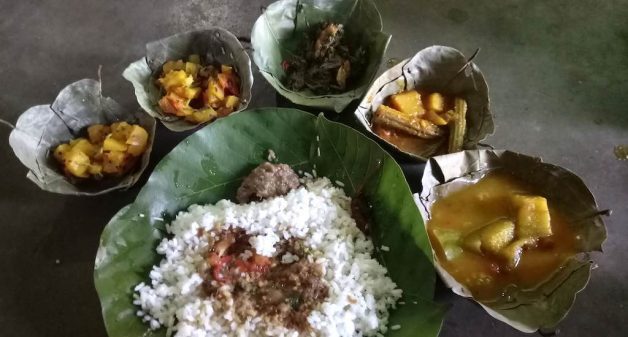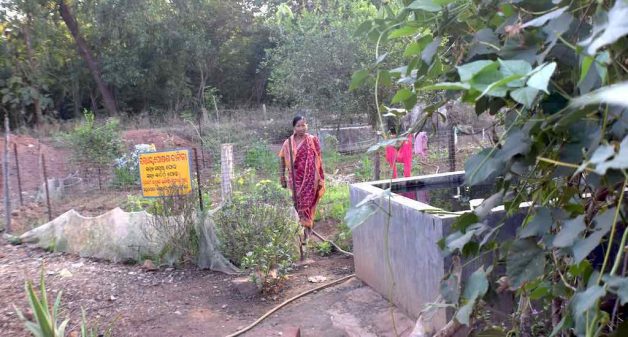
Odisha women fight malnutrition with backyard gardens
Women in distressed and malnourished regions of Odisha are growing nutrition gardens to feed their families organic vegetables and legumes consistently through the year at no additional cost

Women in distressed and malnourished regions of Odisha are growing nutrition gardens to feed their families organic vegetables and legumes consistently through the year at no additional cost
Pramila Behera, 27, of Pengdusi village in Kalahandi district has started her nutrition garden in a small patch of land beside her house. The garden offers her the freedom to decide what kind of food she serves her family.
She grows seasonal, as well as perennial crops like radish, carrot, cauliflower, peas, cowpeas, beans, okra, spinach, coriander, brinjal, tomato, onion, a variety of edible tubers, gourds and greens, to make her garden a rich and reliable source of fresh and nutritious food.
Similar to the traditional kitchen garden, the difference is that Behera grows a wide range of vegetables and legumes so as to fulfill the micronutrient needs of her family.
Nutrition gardens are gathering popularity in many districts of Odisha, including KBK, the area covering Kalahandi, Balangir and Koraput that has been split into eight districts, known for poverty.
Financial liability
“Earlier, I couldn’t fulfill the food needs of my children since we bought vegetables from the market, where prices were too high. We could hardly spend Rs 200 a week on vegetables and provisions,” Behera, working in her garden, told VillageSquare.in. “We don’t buy vegetables anymore.”
At least 12 women of Pengdusi have their own gardens in the backyard and grow more than 15 varieties of vegetables and greens. “We save money we spent earlier at the market buying vegetables at a high price, and eat fresh vegetables that are good for health,” said Radhamani Nayak, the village daycare center worker.
For Padma Naik, 45, of Telguda, buying food from the market to feed her 7-member family was a huge financial burden. “We spent over Rs 1,500 a month on vegetables and that was not sufficient,” Naik told VillageSquare.in. “That’s why we started this; now, we are free to decide our menu.”
A study found that 31% of the households in the region spent Rs 1,000 or less per month on food items, and 55% spent between Rs 1,000 and 2,000. Their food budget was 57% of the total monthly household expenditure.
“Being poor, buying vegetables was a huge burden for us. We could not buy many vegetables because we couldn’t afford them,” said Akshaya Lima of Marathiguda village in Rayagada district. “I am happy now as my wife Nalini has made us food sufficient by growing over 15 varieties of vegetables and greens.”
Balanced diet
Dibyasini Nayak, 16, is happy with the nutrition garden because of the choice it offers. “Earlier we took whatever my mother served. Now, I get to pick – a cucumber, a tomato or a handful of greens,” she said. In Telguda, 25 women raise nutrition gardens to fulfill the nutrition needs of their families.

“When you have to buy vegetables, pulses, eggs and fish, you’ll automatically buy vegetables or whatever is cheaper,” said Sweta Banerjee, Kolkata-based public health nutritionist at Welthungerlife, who has studied nutrition gardens and their role in empowering women and addressing malnutrition in KBK. “But, when you grow vegetables, you can buy eggs or fish since animal protein is also important in the diet.”
Organic produce
Women show interest in nutrition gardens, as there is no financial investment, only some labor. Also, they can feed their family fresh vegetables where no chemical pesticide or inorganic fertilizer has been used.
“We get seeds from farmers and distribute among women. We do not advocate use of hybrid or high-yielding varieties, chemical pesticides or fertilizers,” said Debjeet Sarangi of Living Farms, a non-profit organization that promotes nutrition gardens in the region, with Azim Premji Philanthropic Initiatives (APPI) and Odisha Livelihood Mission (OLM).
“There’s no input cost as improvement of soil health and pest management are through ecological methods,” Sarangi told VillageSquare.in.
Dietary diversity
Dietary diversity is key to improving nutrition security. “Women plan the crops to ensure consistent supply,” said Banerjee. “It ensures consistent micronutrient for the villagers, particularly women and children, who are more prone to malnutrition and ensuing issues.”
Nalini Lima of Marathiguda village takes pride in serving her family’s favorite vegetables and greens, and fulfilling their nutrition needs. “The objective is to improve nutrition status of pregnant and lactating women, adolescent girls and under-5 children, through dietary diversity,” said Sarangi.
Dietary equity
According to the dietary guidelines of Hyderabad-based National Institute of Nutrition, ‘Nutrition is a basic prerequisite to sustain life,’ and ‘variety in food is…the essence of nutrition and health.’ “There is no dietary balance, if the woman has no control over what she cooks; with nutrition garden, she has,” Banerjee told VillageSquare.in.

The gardens also promote equity without any discrimination between male and female members of the family. “Usually male members have the prime share. In families with a nutrition garden, such discrimination is not there,” said Basanti Bag, the accredited social health activist (ASHA) of Telguda.
Mother of an adolescent girl, Sitaguru Kadraka of Krushna Patraguda village in Rayagada district said, “We need not discriminate when we have enough food. Secondly, as future mothers, girls need nourishment.”
Tackling malnutrition
The target being 7,50,000 households, to address chronic malnutrition among tribal population, more than 80,000 households in two malnutrition-affected districts, Rayagada and Kalahandi, have started nutrition gardens.
Diagnosed undernourished six years ago, Alladini Bhanda, 27, and her husband Ashok Bhanda, 34, of Ratanpur village in Balangir district gave credit to their nutrition garden for their weight gain from 35kg and 48kg, to 45kg and 64kg respectively.
“Till I started the nutrition garden in 2013 with support from Reliance Foundation, our daily meal was of rice and one vegetable, cooked or roasted,” said Alladini Bhanda. “Today, I feed my children vegetables so that there won’t be any malnutrition-induced physical and mental weakness.”
Gardens of hope
In Balangir district there are over 2,000 nutrition gardens. “Since they are poor and hit by regular draughts, we supply fences and garden tools,” Abagyanta Das Naik of Reliance Foundation told VillageSquare.in. “We also link women with government departments for farming and nutrition-related advices.”
Since it is fenced, many of us grow banana, lemon and moringa trees to make the gardens more productive,” said Mathura Podha of Ratanpur.
In the tribal pockets of Odisha, 51.8% of adolescent girls and 30.3% of women are undernourished according to a UNICEF report. As per a baseline survey of Women and Child Development department, 72% of under-5 tribal children in the 15 high-burden districts, including KBK, are anemic.
National Family Health Survey 4 (NFHS 4) 2015-16 confirms high prevalence of stunting and wasting among under-5 tribal children in KBK. When the data are so discouraging, nutrition gardens bring hopes of nutrition security.
Basudev Mahapatra is a journalist based in Bhubaneshwar. Views are personal.